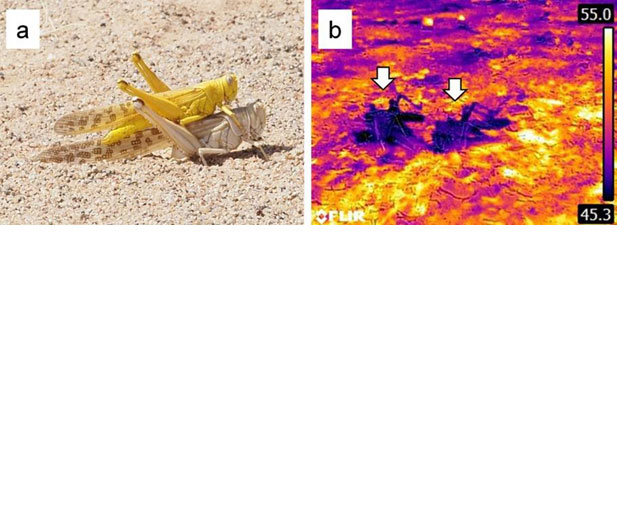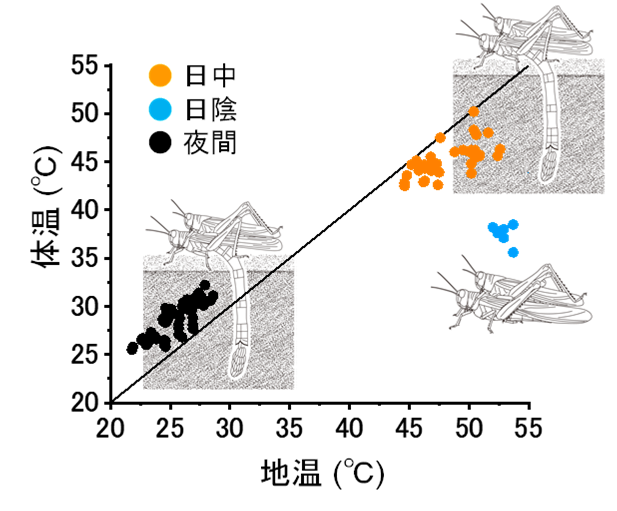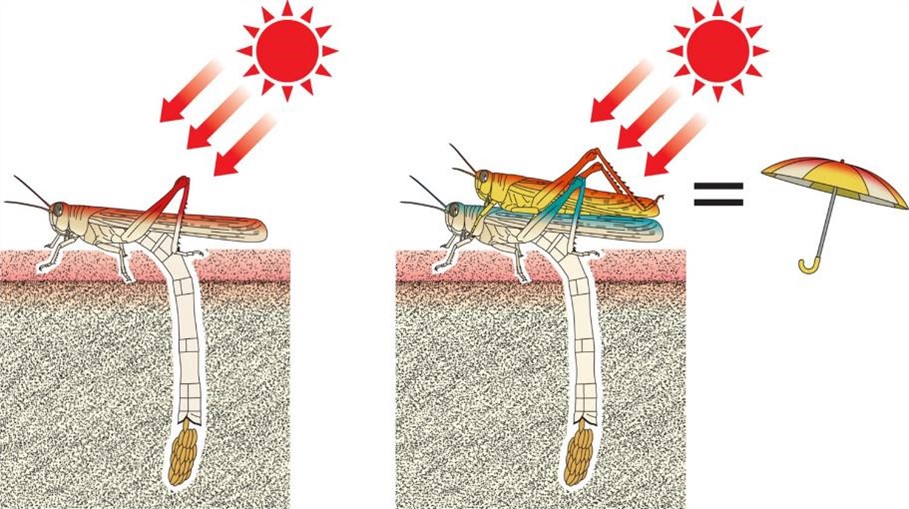研究成果
Understanding the Desert-Adapted Egg-Laying Behavior of Desert Locusts
―Males act as 'parasols' to protect females during egg-laying in high temperatures―
Understanding the Desert-Adapted Egg-Laying Behavior of Desert Locusts
―Males act as 'parasols' to protect females during egg-Laying in high temperatures―
|
Main Points:
|
Overview
JIRCAS, in collaboration with the National Desert Locust Control Center of Mauritania, has elucidated the daytime egg-laying behavior of adult desert locusts (hereinafter referred to as locusts) in the harsh desert environment (extremely high temperatures).
Field surveys conducted in the Sahara Desert revealed that many adult locusts engage in mass egg-laying at night. However, some females were delayed in laying eggs and did so during the day on the surface, where temperatures approached lethal levels (over 50°C), a time when most animals avoid activity. During high temperatures, many males were found riding on the backs of egg-laying females. Using a thermographic camera to measure the body surface temperatures of the locusts, it was found that their body temperatures were lower than the ground temperature. Experimentally, fixed locusts were exposed to sunlight and their body temperatures were directly measured with sensors. It was observed that single females had higher body temperatures, whereas paired females maintained lower body temperatures. This suggests that males riding on the backs of females function as "parasols," helping to avoid high temperatures during egg-laying.
In addition to having a high physiological tolerance to heat (approximately 55°C), locusts lay eggs during times when most animals cannot be active due to high temperatures, with males functioning as "parasols."
From a pest control perspective, paired locusts during mass egg-laying remain in one place for several hours, increasing the efficiency of pesticide application. Applying this understanding of locust behavior can lead to pest control methods that minimize pesticide use and are more environmentally and health-conscious.
The findings of this research were published in the electronic edition of the journal Ecology on September 15, 2024 (Japan time).
Publication
- Authors
- Maeno, K.O., Ould Ely, S., Ould Mohamed, S., Jaavar,M.E.H., Benahi, A.S., and Ould Babah Ebbe, M.A.
- Title
- Mate-guarding male desert locusts act as parasol for ovipositing females in an extremely hot desert environment
- Journal
- Ecology
DOI: https://doi.org/10.1002/ecy.4416
For Inquiries
- JIRCAS President: KOYAMA Osamu
Research Promotion Leader:- Program Director: FUJITA Yasunari (Food Program)
- Research Staff:
- MAENO Kotaro (Senior Researcher, Crop, Livestock and Environment Division)
- Public Relations Officer:
- OMORI Keisuke (Head, Information and Public Relations Office)
Press e-mail: koho-jircas@ml.affrc.go.jp
- OMORI Keisuke (Head, Information and Public Relations Office)
Figure 2: Body temperature of egg-laying desert locusts
During the day, the body temperature of egg-laying pairs in sunlight is lower than the ground temperature (orange).
Pairs not laying eggs in the shade have an even lower body temperature (light blue).
At night, the body temperature of egg-laying pairs is higher than the ground temperature (black).
The black diagonal line represents a 1:1 ratio between ground temperature and body temperature.
Figure 3: Egg-laying conditions of single and paired Females in high temperatures
During the day, egg-laying females insert their abdomens into the ground to lay eggs.
Single females are exposed to extremely high temperatures during the day (left image).
Paired females, with males functioning as "parasols" on their backs, avoid high temperatures and lay eggs (right image).





